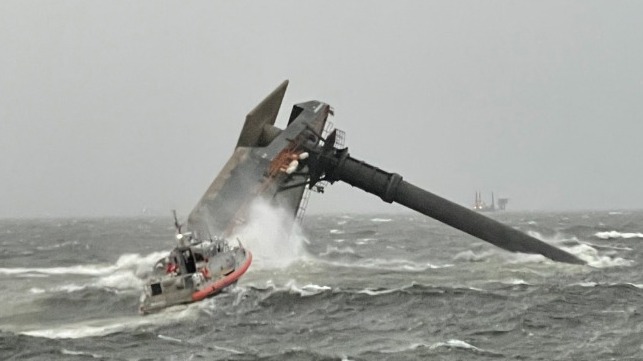NTSB Issues Preliminary Report Detailing Seacor Power Capsizing

As part of its ongoing investigation into the loss of the liftboat Seacor Power, the National Transportation Safety Board published a summary of facts as a preliminary report into the fatal accident that left seven people missing, and six bodies recovered after the accident. While the NTSB cautions that no conclusions about the cause of the accident should be drawn from the report, it provides the first glimpse into the events that lead up to the vessel capsizing on April 13, 2021, near Port Fourchon, Louisiana.
The statement confirms previous speculation that the crew of the Seacor Power had attempted to stabilize the vessel as the storm intensified. They also reported that the intensity of the weather and the fact that it persisted well into the following day hampered efforts to reach the vessel and rescue individuals that survived the accident.
NTSB investigators learned that at about 3:30 p.m., as the Seacor Power transited the open waters of the Gulf, a squall passed over the liftboat. With visibility dropping and winds increasing significantly, the crew decided to lower the Seacor Power's legs to the seafloor to hold the vessel in position until the storm passed. The crewmember at the helm attempted to turn the Seacor Power into the wind as the legs began to descend. Before the turn was completed, the liftboat heeled to starboard and capsized.
Piecing together the events of the day, they said a weather report emailed to the vessel at 7:02 a.m. the day of the accident predicted afternoon winds at 9 to 12 knots from the southeast with 3-foot seas. The Seacor Power departed Port Fourchon at about 1:30 p.m. April 13, bound for the oil and gas lease area Main Pass Block 138 in the Gulf of Mexico. The 19 people aboard included nine crew, two galley staff, and eight offshore workers. The vessel was expecting an 18-hour trip at four knots to the worksite. Before getting underway, equipment to be used by the offshore workers was loaded on the Seacor Power’s main deck.
NTSB investigators also learned several people were able to escape onto the exposed, port side of the Seacor Power deckhouse. High winds and seas that had built to 10 to 12 feet prevented rescuers from reaching those who remained on the liftboat. Some were washed into the water and six were eventually rescued, with one survivor suffering a serious injury.
Other vessels in the area provided the NTSB with weather reports showing that in addition to heavy rain, winds exceeded 80 knots creating building seas at the time of the accident. Search and rescue responders reported that their efforts were hampered by 30 to 40 knot winds that persisted throughout the evening and into the next day.

that matters most
Get the latest maritime news delivered to your inbox daily.
Information in the report is preliminary and subject to change as the investigation progresses the NTSB says, but their investigators have interviewed survivors, other personnel who previously crewed the Seacor Power, representatives for the owner and charterer, vessel inspectors and surveyors, and search and rescue responders.
When the Seacor Power is salvaged, NTSB investigators intend to return to inspect the vessel and collect further evidence.
